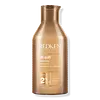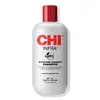What's inside
What's inside
 Key Ingredients
Key Ingredients

No key ingredients
 Benefits
Benefits

 Concerns
Concerns

 Ingredients Side-by-side
Ingredients Side-by-side

Water
Skin ConditioningSodium Laureth Sulfate
CleansingSodium Chloride
MaskingCocamidopropyl Betaine
CleansingDimethicone
EmollientParfum
MaskingSodium Benzoate
MaskingAmodimethicone
Carbomer
Emulsion StabilisingGlycerin
HumectantGuar Hydroxypropyltrimonium Chloride
Skin ConditioningTrideceth-10
CleansingSalicylic Acid
MaskingHexylene Glycol
EmulsifyingGlycol Distearate
EmollientCitric Acid
BufferingMica
Cosmetic ColorantSodium Cocoyl Amino Acids
CleansingPEG-100 Stearate
Phenoxyethanol
PreservativeSteareth-6
EmulsifyingTrideceth-3
EmulsifyingPotassium Dimethicone PEG-7 Panthenyl Phosphate
Skin ConditioningCI 77891
Cosmetic ColorantSodium Sarcosinate
Benzyl Alcohol
PerfumingPropylene Glycol
HumectantCoumarin
PerfumingLinalool
PerfumingPEG-45m
HumectantBenzyl Benzoate
AntimicrobialHexyl Cinnamal
PerfumingLimonene
PerfumingAloe Barbadensis Leaf Juice Powder
Skin ConditioningArginine
MaskingHydrolyzed Soy Protein
HumectantPlukenetia Volubilis Seed Oil
EmollientCaramel
Cosmetic ColorantAcetic Acid
BufferingFumaric Acid
BufferingHydrolyzed Vegetable Protein Pg-Propyl Silanetriol
Skin ConditioningCereus Grandiflorus Flower Extract
Skin ConditioningGlucose
HumectantLactic Acid
BufferingPotassium Sorbate
PreservativeTetrasodium EDTA
BHT
AntioxidantTocopherol
AntioxidantSodium Hydroxide
BufferingWater, Sodium Laureth Sulfate, Sodium Chloride, Cocamidopropyl Betaine, Dimethicone, Parfum, Sodium Benzoate, Amodimethicone, Carbomer, Glycerin, Guar Hydroxypropyltrimonium Chloride, Trideceth-10, Salicylic Acid, Hexylene Glycol, Glycol Distearate, Citric Acid, Mica, Sodium Cocoyl Amino Acids, PEG-100 Stearate, Phenoxyethanol, Steareth-6, Trideceth-3, Potassium Dimethicone PEG-7 Panthenyl Phosphate, CI 77891, Sodium Sarcosinate, Benzyl Alcohol, Propylene Glycol, Coumarin, Linalool, PEG-45m, Benzyl Benzoate, Hexyl Cinnamal, Limonene, Aloe Barbadensis Leaf Juice Powder, Arginine, Hydrolyzed Soy Protein, Plukenetia Volubilis Seed Oil, Caramel, Acetic Acid, Fumaric Acid, Hydrolyzed Vegetable Protein Pg-Propyl Silanetriol, Cereus Grandiflorus Flower Extract, Glucose, Lactic Acid, Potassium Sorbate, Tetrasodium EDTA, BHT, Tocopherol, Sodium Hydroxide
Water
Skin ConditioningSodium C14-16 Olefin Sulfonate
CleansingCocamidopropyl Betaine
CleansingGlycol Distearate
EmollientDisodium Laureth Sulfosuccinate
CleansingHydrolyzed Silk
HumectantPanthenol
Skin ConditioningCocodimonium Hydroxypropyl Hydrolyzed Keratin
Skin ConditioningAcrylates Copolymer
Caprylyl Glycol
EmollientPhenoxyethanol
PreservativePEG-150 Pentaerythrityl Tetrastearate
EmulsifyingPolyquaternium-10
Disodium EDTA
PEG-6 Caprylic/Capric Glycerides
EmulsifyingPotassium Sorbate
PreservativeHexylene Glycol
EmulsifyingCitric Acid
BufferingParfum
MaskingBenzyl Benzoate
AntimicrobialHexyl Cinnamal
PerfumingWater, Sodium C14-16 Olefin Sulfonate, Cocamidopropyl Betaine, Glycol Distearate, Disodium Laureth Sulfosuccinate, Hydrolyzed Silk, Panthenol, Cocodimonium Hydroxypropyl Hydrolyzed Keratin, Acrylates Copolymer, Caprylyl Glycol, Phenoxyethanol, PEG-150 Pentaerythrityl Tetrastearate, Polyquaternium-10, Disodium EDTA, PEG-6 Caprylic/Capric Glycerides, Potassium Sorbate, Hexylene Glycol, Citric Acid, Parfum, Benzyl Benzoate, Hexyl Cinnamal
 Reviews
Reviews

Ingredients Explained
These ingredients are found in both products.
Ingredients higher up in an ingredient list are typically present in a larger amount.
Benzyl Benzoate is usually created from the condensation of benzoic acid and benzyl alcohol. It is used as a preservative, solvent, and has a floral/balsamic scent in large amounts.
As a preservative, Benzyl Benzoate works against bacteria and fungus. It is often used to treat scabies and lice in medicine.
Solvents are used to keep ingredients together in a product. They can help dissolve ingredients to stable bases or help evenly distribute ingredients throughout the product.
Due to its fragrance, Benzyl Benzoate can be sensitizing and may cause contact dermatitis. It is a known EU allergen. We recommend speaking with a professional if you have any concerns.
Benzyl Benzoate can be naturally found in cranberries and peaches.
Learn more about Benzyl BenzoateCitric Acid is an alpha hydroxy acid (AHA) naturally found in citrus fruits like oranges, lemons, and limes.
Like other AHAs, citric acid can exfoliate skin by breaking down the bonds that hold dead skin cells together. This helps reveal smoother and brighter skin underneath.
However, this exfoliating effect only happens at high concentrations (20%) which can be hard to find in cosmetic products.
Due to this, citric acid is usually included in small amounts as a pH adjuster. This helps keep products slightly more acidic and compatible with skin's natural pH.
In skincare formulas, citric acid can:
While it can provide some skin benefits, research shows lactic acid and glycolic acid are generally more effective and less irritating exfoliants.
Most citric acid used in skincare today is made by fermenting sugars (usually from molasses). This synthetic version is identical to the natural citrus form but easier to stabilize and use in formulations.
Read more about some other popular AHA's here:
Learn more about Citric AcidCocamidopropyl Betaine is a fatty acid created by mixing similar compounds in coconut oil and dimethylaminopropylamine, a compound with two amino groups.
This ingredient is a surfactant and cleanser. It helps gather the dirt, pollutants, and other impurities in your skin to be washed away. It also helps thicken a product and make the texture more creamy.
Being created from coconut oil means Cocamidopropyl Betaine is hydrating for the skin.
While Cocamidopropyl Betaine was believed to be an allergen, a study from 2012 disproved this. It found two compounds in unpure Cocamidopropyl Betaine to be the irritants: aminoamide and 3-dimethylaminopropylamine. High-grade and pure Cocamidopropyl Betaine did not induce allergic reactions during this study.
Learn more about Cocamidopropyl BetaineGlycol Distearate serves as a pearlizing or opacifying agent in cosmetic products.
It's often included in cleansers and haircare products to give them a lustrous or shimmering appearance.
It is derived from stearic acid, a natural fatty acid commonly found in vegetable oils and animal fats.
Glycol Distearate isn't fungal acne safe.
Learn more about Glycol DistearateHexyl Cinnamal is a fragrance ingredient with a similar scent to jasmine. It can be naturally found in chamomile essential oil.
This ingredient is a known EU allergen and may sensitize the skin. The EU requires this ingredient to be listed separately on an ingredients list.
Hexyl Cinnamal is not water soluble but is soluble in oils.
Learn more about Hexyl CinnamalHexylene Glycol is a surfactant. Glycols are a class of alcohols. Hexylene Glycol is a surfactant and emulsifier.
As a surfactant, Hexylene Glycol helps gather dirt and oil on your skin to be washed away.
As an emulsifier, Hexylene Glycol helps keep water and oil together. This prevents them from separating in a product. Hexylene Glycol also thins out the texture of a product by lessening viscosity.
Hexylene Glycol has a small molecular weight.
Learn more about Hexylene GlycolParfum is a catch-all term for an ingredient or more that is used to give a scent to products.
Also called "fragrance", this ingredient can be a blend of hundreds of chemicals or plant oils. This means every product with "fragrance" or "parfum" in the ingredients list is a different mixture.
For instance, Habanolide is a proprietary trade name for a specific aroma chemical. When used as a fragrance ingredient in cosmetics, most aroma chemicals fall under the broad labeling category of “FRAGRANCE” or “PARFUM” according to EU and US regulations.
The term 'parfum' or 'fragrance' is not regulated in many countries. In many cases, it is up to the brand to define this term.
For instance, many brands choose to label themselves as "fragrance-free" because they are not using synthetic fragrances. However, their products may still contain ingredients such as essential oils that are considered a fragrance by INCI standards.
One example is Calendula flower extract. Calendula is an essential oil that still imparts a scent or 'fragrance'.
Depending on the blend, the ingredients in the mixture can cause allergies and sensitivities on the skin. Some ingredients that are known EU allergens include linalool and citronellol.
Parfum can also be used to mask or cover an unpleasant scent.
The bottom line is: not all fragrances/parfum/ingredients are created equally. If you are worried about fragrances, we recommend taking a closer look at an ingredient. And of course, we always recommend speaking with a professional.
Learn more about ParfumPhenoxyethanol is a preservative that has germicide, antimicrobial, and aromatic properties. Studies show that phenoxyethanol can prevent microbial growth. By itself, it has a scent that is similar to that of a rose.
It's often used in formulations along with Caprylyl Glycol to preserve the shelf life of products.
Potassium Sorbate is a preservative used to prevent yeast and mold in products. It is commonly found in both cosmetic and food products.
This ingredient comes from potassium salt derived from sorbic acid. Sorbic acid is a natural antibiotic and effective against fungus.
Both potassium sorbate and sorbic acid can be found in baked goods, cheeses, dried meats, dried fruit, ice cream, pickles, wine, yogurt, and more.
You'll often find this ingredient used with other preservatives.
Learn more about Potassium SorbateWater. It's the most common cosmetic ingredient of all. You'll usually see it at the top of ingredient lists, meaning that it makes up the largest part of the product.
So why is it so popular? Water most often acts as a solvent - this means that it helps dissolve other ingredients into the formulation.
You'll also recognize water as that liquid we all need to stay alive. If you see this, drink a glass of water. Stay hydrated!
Learn more about Water